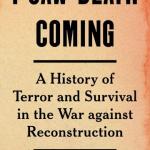I Saw Death Coming: A History of Terror and Survival in the War Against Reconstruction

I Saw Death Coming: A History of Terror and Survival in the War against Reconstruction
Kidada E. Williams
Bloomsbury Publishing
ISBN: 9781635576634
Edward Crosby insisted on his right to vote in St. Landry’s Parish, Louisiana. Samuel and Hannah Tutson farmed their own land in central Florida. Warren Jones refused to be cheated by the man who owned the land on which he sharecropped in Georgia. For these transgressions, the Crosby, Tutson, and Jones families, like thousands of other Black people, were terrorized by “night riders” in the years following the Civil War.
The harrowing title of Kidada E. Williams’ new book, I Saw Death Coming, is a quote from Abraham Brumfield of South Carolina, who was targeted, along with his wife, Emeline, because he engaged in “big talk” about his civil and political rights. (Each chapter title, except for the wrap-up, directly quotes a survivor.) Williams, an associate professor of history at Wayne State University, places us inside people’s homes, alongside them in bed in some cases, as they hear men riding up on horseback and must calculate in a split second whether to fight, flee, or hide.
One estimate from the 1890s was that 53,000 people were killed by night riders. But really, there is no tally of the number of deaths, nor of the many thousands more who were physically harmed and psychologically traumatized; of the property burnt, stolen, or destroyed; or of the spillover fear and insecurity suffused throughout communities. While each attack was unique, they shared some horrific characteristics. Groups of white men, from a few to many dozen, charged up in darkness with the specific intent to threaten and intimidate Black people in their homes, to violate their sanctuaries. They wore the robes of “the Ku-Klux” or other masks to hide their identities and look more menacing.
Night riders almost always targeted the man of the house, pursuing him in the presence of his family to inflict even more trauma. In fact, as Williams describes it, “lying out” became one defense tactic: Black men would sleep away from their homes — whether outside in the woods or further away, often for weeks at a time and in all types of weather — so they wouldn’t be there when the mob arrived.
Williams’ accounts principally come from testimonies given at Congressional hearings held in six Southern states in 1871 and 1872. Only a small percentage of victims had the fortitude, not to mention the logistic capability, to travel to a hearing and relive their experiences by responding to a set of often obtrusive questions, all the while knowing their attackers could come after them again. They received no compensation or legal remediation, but they nonetheless spoke up. Their stories, the author notes, were published and available yet largely forgotten over time.
Commenting on another of her trove of sources — oral accounts from terrorized Black families collected by the Works Progress Administration in the 1930s — Williams observes that, 50 years after the fact, “the abundance of discussion of Reconstruction-era atrocities…attests to how central they were to Black family histories.”
Stepping away from ground zero, Williams draws on neuroscience to untangle the effects of the violence. Quoting neuropsychiatrist Bessel van der Kolk (“the body keeps the score”), she explains what might have happened physiologically as victims responded to assault in real time and then processed the experience afterward. We now understand what trauma does to the body, brain, and soul; without knowing the science, these people lived it.
Who helped them? Almost no one. As Williams details, white people did virtually nothing to prevent or punish the late-19th-century violence. Some who were in positions to help — sheriffs, judges, etc. — were actually complicit, while others chose not to stick their necks out for Black people. The Freedmen’s Bureau and U.S. Army troops who tried to intervene were too few and too scattered to have much effect. Most Northern whites wanted to move on from the Civil War and turned away from the violence and, more broadly, from what Reconstruction was trying to achieve. Back in victims’ communities, Black neighbors sometimes offered assistance after an assault (and even banded together to resist) but were themselves extremely vulnerable.
To fulfill the promise of the book’s subtitle (A History of Terror and Survival in the War against Reconstruction), Williams writes about how people overcame the horror of the night riders. “That so many lived to tell their stories is a testament to how shrewd their many calculations for surviving raids were,” she points out. This was indeed war, she maintains — in this case, a war against Black equality during Reconstruction. It was “not the impulsive antics of defeated soldiers. It was the pursuit of the Confederate cause by other means.”
While she does not include the accounts of all those who participated in the Klan hearings, Williams lists in an appendix all the testifiers’ names, family members (or at least numbers of children), and home counties, as well as where readers can go to locate their complete transcripts.
Reading these survivors’ words, even from a distance of time and place, is excruciating. Untold numbers of men, women, and children suffered sadistic abuse during the time America was allegedly healing from the Civil War. Yet “this history faded from national memory,” Williams writes. By focusing on the people — Edward Crosby, the Tutsons, and others — she ensures that their heroism is no longer forgotten and our country’s history is accurately portrayed.
Paula Tarnapol Whitacre writes about history, with a focus on 19th-century social history. She is currently working on a book about the Civil War and Reconstruction focused on Alexandria, Virginia.
